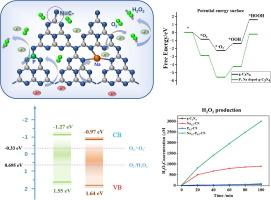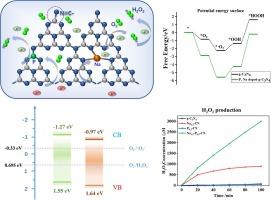Synergistic regulation of g-C3N4 band structure by phosphorus and sodium doping to enhance photocatalytic hydrogen peroxide production efficiency
IF 6.5
1区 化学
Q2 CHEMISTRY, PHYSICAL
引用次数: 0
Abstract
In addressing the industrial need for a simple, equipment-minimal, and non-toxic method of in-situ hydrogen peroxide (H2O2) production, this paper presents a cost-effective, environmentally friendly photocatalyst. Our design strategy focuses on the dual-element doping of phosphorus and sodium into graphitic carbon nitride (g-C3N4), chosen to synergistically enhance photocatalytic performance. This approach yields a notable H2O2 production concentration of 3001.64 μmol·g−1·L-1 within 100 min, using isopropanol as a sacrificial agent, which was 61-fold increase compared to bulk g-C3N4. Density Functional Theory (DFT) calculations were performed to elucidate the alterations in the band structure of the catalyst induced by dual-element doping, which consequentially engendered an asymmetric intrinsic electric field. Additionally, oxygen’s transition state affinity due to phosphorus doping was also investigated to reveal the mechanisms of synergistic catalysis. This development contributes to meeting industrial demands for pollutant degradation via Fenton processes and presents a sustainable alternative to traditional H2O2 production methods.


磷和钠掺杂对 g-C3N4 带状结构的协同调控可提高光催化产生过氧化氢的效率
为了满足工业界对简单、设备最少、无毒的原位生产过氧化氢(H2O2)方法的需求,本文介绍了一种经济高效、环境友好的光催化剂。我们的设计策略侧重于在氮化石墨碳(g-C3N4)中掺入磷和钠的双元素,以协同提高光催化性能。这种方法使用异丙醇作为牺牲剂,在 100 分钟内产生的 H2O2 浓度达到 3001.64 μmol-g-1-L-1,是块状 g-C3N4 的 61 倍。密度泛函理论(DFT)计算阐明了双元素掺杂引起的催化剂能带结构的变化,从而产生了不对称的本征电场。此外,还研究了磷掺杂导致的氧过渡态亲和性,以揭示协同催化的机制。这项研究成果有助于满足工业界通过芬顿过程降解污染物的需求,并为传统的 H2O2 生产方法提供了一种可持续的替代方法。
本文章由计算机程序翻译,如有差异,请以英文原文为准。
求助全文
约1分钟内获得全文
求助全文
来源期刊

Journal of Catalysis
工程技术-工程:化工
CiteScore
12.30
自引率
5.50%
发文量
447
审稿时长
31 days
期刊介绍:
The Journal of Catalysis publishes scholarly articles on both heterogeneous and homogeneous catalysis, covering a wide range of chemical transformations. These include various types of catalysis, such as those mediated by photons, plasmons, and electrons. The focus of the studies is to understand the relationship between catalytic function and the underlying chemical properties of surfaces and metal complexes.
The articles in the journal offer innovative concepts and explore the synthesis and kinetics of inorganic solids and homogeneous complexes. Furthermore, they discuss spectroscopic techniques for characterizing catalysts, investigate the interaction of probes and reacting species with catalysts, and employ theoretical methods.
The research presented in the journal should have direct relevance to the field of catalytic processes, addressing either fundamental aspects or applications of catalysis.
 求助内容:
求助内容: 应助结果提醒方式:
应助结果提醒方式:


